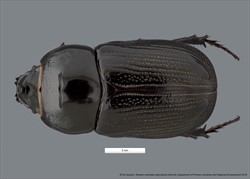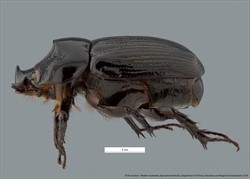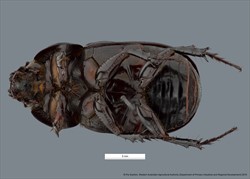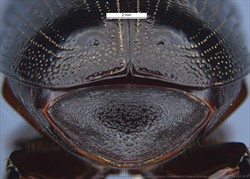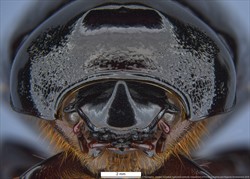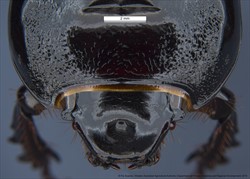Sub family: Dynastinae / Tribe: Pentodontini / Genus: Papuana
Fact Sheet
Papuana Arrow, 1911
Medium to large broadly cylindrical beetles, body length 15-30mm. Body colouration shiny black, rarely reddish brown. Pronotum of males usually with a short horn, centrally located, or closer to the posterior margin. Fovea often present, with pronotal horn located distally. Rarely completely convex with no horn or fovea. Frons of males with either 1 or 2 horns. Clypeus with a truncated apex and dentate anterior angles. Mandibles visible dorsally, with 2-3 teeth on the outer edge. Antennae with 10 segments, and a 3-segmented club that is short and not sexually dimorphic. Elytra with distinct punctate rows, rarely lacking and smooth. Stridulatory area of propygidium present and variably developed. Foretibia tri- or quadri-dentate. Hind tibia with a truncated apex. Tarsal claws simple.
Papuana, or Taro beetle, are pests of various tropical crops including taro, oil and coconut palms, banana, cocoa and sugar cane. The damage is done by the adult beetles, burrowing into the growing points of the host plants, particularly the underground corms of taro. Larvae live in the surrounding soil feeding on decaying organic matter, and do not cause damage to plants. Adult beetles are attracted to lights at night.
Papuana are primarily Pupua New Guinean in origin. Species are present throughout the surrounding region, including the Philippines, Moluccas, Solomon Islands, Vanuatu, Kiribati and Fiji. The Australian distribution of P. woodlarkiana is limited to Northern Queensland.
Hawaiian Scarab ID fact sheet: http://idtools.org/id/beetles/scarab/factsheet.php?name=15232
PaDIL image sets: http://www.padil.gov.au/pests-and-diseases/search?queryText1=papuana&queryType1=all
PestNet -Pacific Pests and Pathogens fact sheet: http://www.pestnet.org/fact_sheets/taro_papuana_beetle_030.htm
Carne, P.B. 1957, A Systematic Revision of the Australian Dynastinae: (Coleoptera: Scarabaeidae). CSIRO, Melbourne. 284pp.
Endrödi, S. 1985 The Dynstinae of the World. W. Junk. London. 800pp.
Weir, T.A., Lawrence, J.F., Lemann, C., Gunter, N.L. 2019. 33. Scarabaeidae: Dynastinae Macleay, 1919. In: Australian Beetles. Volume 2. Archostemata, Myxophaga, Adephaga, Polyphaga (part) (eds A Ślipiński & JF Lawrence) pp. 516–530. CSIRO, Clayton, Australia.

